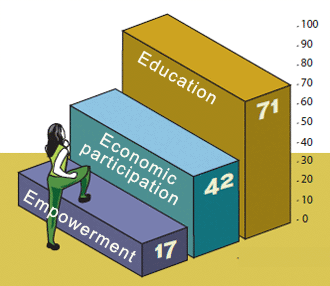Measuring Inequity: The 2012 Gender Equity Index
The Gender Equity Index (GEI) measures the gap between women and men in education, the economy and political empowerment.
Social Watch computes a value for the gender gap in each of the three areas in a scale from 0 (when for example no women is educated at all and all men are) to 100 (perfect equality). The GEI, in turn, is the simple average of the three dimensions. In Education, GEI looks at the gender gap in enrolment at all levels and in literacy; economic participation computes the gaps in income and employment and empowerment measures the gaps in highly qualified jobs, parliament and senior executive positions.
Measuring the gap
The GEI measures the gap between women and men, not their well-being. Thus, a country in which young men and women have equal access to the university receives a value of 100 on this particular indicator. In the same fashion, a country in which boys and girls are equally barred from completing primary education would also be awarded a value of 100. This does not mean that the quality of education in both cases is the same. It just establishes that, in both cases girls are not less educated than boys.
BIG STEPS AHEAD
 |
||||||
|
Overall in the world, the gender gap in education is narrower than that in the other two components. While the world value for education is 71 (or LOW, according to GEI categories), that for economic participation is 42 (VERY LOW) while women participation in decision making reaches a meagre 17 (CRITICAL).
Women’s participation in the labor force is significantly less compared to men. They have substantially lower salaries for the same type of work and a higher percentage of women are employed in vulnerable or irregular jobs. But more importantly, in no country do women have the same opportunities as men to participate in economic and social decision-making processes. Women still take the back seat even if they have achieved significant strides in education and economic participation.
Even in those countries where the relative situation of women is better, the gender gap in empowerment remains substantial.